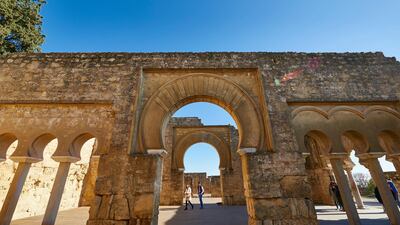Thirty wonders of the modern and ancient worlds are in the running for official recognition by Unesco when the World Heritage Committee meets in Bahrain this week.
From Saudi Arabia's Al Ahsa Oasis to the Caliphate City of Medina Azahara in what was once Islamic Spain, experts will determine if nominations meet the criteria to be recognised globally as among the most significant artefacts of their kind.
The Ancient City of Qalhat in Oman and the Dubai Creek are also among the entries to Unesco.
In Europe, the memorial sites of the First World War's Western Front in Belgium and France are among the most high profile entries.
Sites granted official Unesco status often see a surge in visitor numbers, investment and funding.
Several hundred people took part in the ceremony on Sunday, which was opened by the President of the Bahraini Authority for Culture and Antiquities, Sheikha Mai Bint Mohammed Al-Khalifa, the Chair of the 42nd session of the World Heritage Committee, Sheikha Haya Bint Rashed Al-Khalifa, and the Director General of Unesco, Audrey Azoulay.
“Expectations of this session are high and we must seize this opportunity to strengthen joint work for the safeguarding of cultural heritage," said Sheikha Haya Bint Rashed Al-Khalifa, quoted in a Unesco news release.
She spoke of her country’s two World Heritage sites, Qal'at al-Bahrain – Ancient Harbour and Capital of Dilmun, and Pearling, Testimony of an Island Economy, and recalled that Bahrain is chairing the World Heritage Committee for the second time.
“It is significant that this year the Committee is being held in an Arab country,” said the director-general, who reminded participants that at the 1972 Convention Concerning the Protection of the World Cultural and Natural Heritage has its roots in the campaigns to safeguard the Egyptian sites of Abu Simbel and Philae.
The director-general went on to say: “Across Iraq, over 100 cultural heritage sites have been destroyed, many of which are in Mosul.
"Last February, Unesco launched an initiative to Revive the spirit of Mosul, in partnership with the Iraqi authorities.”
The committee will also examine the state of conservation of 157 sites already inscribed on the List, 54 of which are on the List of World Heritage in Danger.
The Chairperson of Unesco’s Executive Board, Lee Byong-hyun, said that “the World Heritage Convention, as Unesco's most universally recognised normative instrument, is a remarkable example of how collaboration among nationals through education, science and culture can be put into practice through common effort.”
To get on the Unesco heritage list, an entry must be shown to be of "outstanding universal value" and meet at least one of 10 criteria which include representing a masterpiece of human creative genius, an outstanding human settlement, using land or sea, or human interaction with the environment, especially one which has become vulnerable because of under the impact of irreversible change.
The list is comprised of five natural sites, and 22 cultural sites.
The UAE is currently home to a single entry on the World Heritage List – the collective cultural sites of Al Ain, including the Hafit, Hili, Bidaa Bint Saud and Oases Areas.
There are more than 1,000 World Heritage Sites in total – and many countries have multiple entries, from natural sites to urban landscapes.
Scotland's capital Edinburgh became one of the first urban environments to be included in the list in the 1990s, and since then more have been added, including Liverpool's famous dock district, noted for its commerce and shipbuilding and renowned architecture.
"In the 1990s there was a period where World Heritage Sites were no longer individual monuments, such as Stonehenge," Nicholas Hotham, head of external relations for Edinburgh World Heritage, told The National on Monday.
“Nor were they natural parks or natural environments. There was a recognition that complex urban environments could also be recognised as World Heritage Sites.”
“It’s an extensive process to go through in terms of firstly being included on the tentative list and then for the formal submission to occur,” said Mr Hotham.
Unesco officials will meet in Bahrain until July 4.
The advisory bodies' evaluation of the proposed sites are available online and the debates of the session will be webcast.
_____________
Read more:
Traditional UAE poetry offered protected Unesco status
Quest to place Dubai Creek on World Heritage list
Dubai Creek to receive upgrade as part of Unesco World Heritage site bid
_____________


